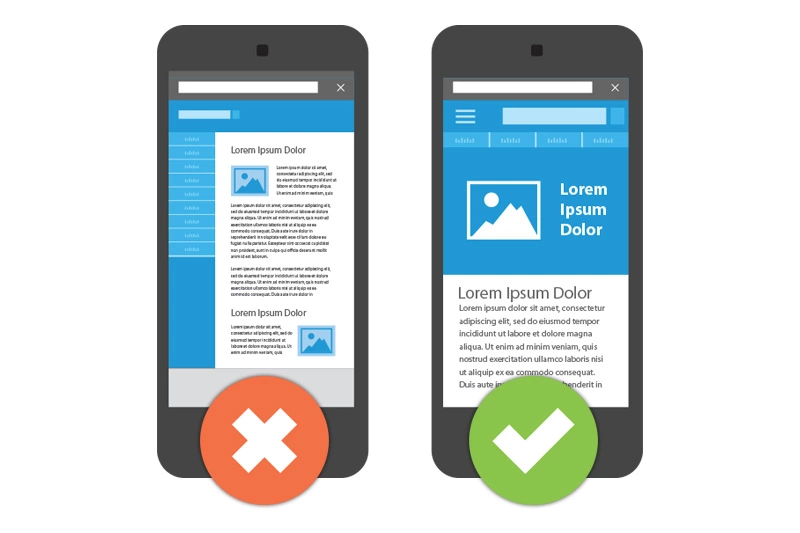Does your website need Redesign?
Over 40% of small businesses still don’t have a website, and the sad part is, they don’t have any idea how much they are missing out on this digital era.
The other 60% of small businesses that do have, might be thinking, the website is set for life. While recognizing the importance of having an online presence and actually doing something about it, we are going to discuss what’s wrong and why.
Small businesses only can do so much of the heavy lifting like attracting new prospects to the website. To convince more visitors to their website, they want to work with you or buy from you.
But most websites just aren’t set up to be successful. So, you may be wondering at this point if a redesign is necessary.
6 signs to know if your website needs a Redesign
1) Mobile friendly (A Must)
For the first time in history, more people are visiting websites from their smartphones than desktops. iPhone may have debuted way back in 2007, but it would take over 10 years for mobile website traffic to finally eclipse the well-established desktop experience.
In 2015, mobile devices only accounted for less than one-third of all Internet traffic. As smartphones became more affordable and mobile networks juiced up their download speeds. Mobile Internet traffic worldwide exploded from 31% to 52% in just 2 short years.
The mobile user experience should be your new number one priority. How many potential customers are you losing because your contact us button is too small to easily thumbtack? Your embedded YouTube video is too wide to fit within the phone screen.
Your transparent navigation menu overlaps with your header image making it difficult to see your company’s logo or your paragraph text is too small to read. Little mistakes like these are simply unacceptable in 2021. The margin for error is too slim to risk irritating your visitors and watching them take off to your competitors.
It’s time to design your website with mobile as your priority because one thing is certain, we aren’t crawling back to our bulky desktop computers anytime soon.
2) Branding
People often confuse branding with logo design. But the truth is branding is all-encompassing from everything from your logo to all of your marketing materials including your website. To put it another way, your branding is the personality of your business it’s the feeling you want people to associate with you.
So if you change your logo or any of your other branding elements everything needs to match so that may not necessarily mean a ground-up redesign but it definitely at least means a rethinking of the overall look and feel.
Similarly, if you change what you offer what you do fundamentally you’re gonna need new written content for that. Now the problem is you don’t want to just shoehorn this new written content into the slots leftover from your current website.
So you may need to start thinking to redesign at that point and the extent of that is gonna really depend on how much of a departure your new content is from your old content.
The next reason for a redesign is if your customers aren’t engaged and then read the way you would know this is by looking into your Google Analytics. So let’s say you look at your analytics and you can tell them when people are coming to your site they’re just bouncing right off it’s called bounce rate that’s generally not a good sign.
But actually, the main metric to look at here is time on-site in other words how long people are sticking around and engaging with your pages. And the reason I’d like to look at the time on the page more than a bounce rate is pretty simple because our bounce rates can be deceiving.
3) Customers engagement
Imagine if you’ve got a great homepage the people are finding everything they need on that homepage and then they’re leaving at that point that’s not necessarily a bad thing but it’s still considered a bounce because they haven’t gone to any other pages.
On the other hand, if they’re coming and leaving within like 5 or 10 seconds that is a much bigger issue because that means either what they’re seeing is confusing or it isn’t persuasive or it might just be a really outdated design that’s not inspiring any trust in you as a business.
Depending on what the problem actually is you know a redesign complete with the whole rethinking of your written content we’d probably go a long way to fixing that problem.
4) Over complicated
The next reason is if it’s too complicated so most businesses tend to say way too much on their website and offer way too many pages. It sounds like a good thing, right?
It sounds like you’re catering to everybody, but the truth is whenever you include too much content and give people too many choices people just tend to really get lost in the weeds and not know where to go next.
The better thing to do is really to concentrate on those handfuls of pages that are going to lead to a sale or at least lead to someone becoming a lead that you can keep in front of overtime. This might actually be a really simple fix. It might just be about restructuring the navigation tabs in your header.
You know, prioritizing what should go up there that’s really important and what’s not so important that might be better to move it to the footer menu. Or it might be a good time to just start fresh especially if you’re trying to fix any of the other problems on this list at the same time.
5) No call to action
If your website isn’t set up to get you clients, now and later. If your website isn’t continually bringing in your new business it isn’t doing its job.
So, I definitely always recommend every website needs two different calls to action.
You might need a redesign for this because there’s a lot of planning involved and where to put all these different elements on your site, especially a really strong opt-in section for your lead magnet which is how you start building that list of future customers.
Also, you need to plan out the colors and the overall style of your call to action buttons. I advise that your main call to action button should be big bright and bold so that it stands out against all the other elements on the page.
And not only that but whatever color you choose for your call-to-action button should not be used anywhere else on the site it is reserved just for that main call-to-action button and then you’ll also give different color to your secondary call-to-action button.
This basically eliminates all the guesswork involved in what someone has to do to become a client or customer.
6) Deliver message to your ideal customer
One thing that doesn’t always come naturally to businesses on their website is to talk in a way that means something to their ideal customers.
The way you do that is through a customer saga story where you basically present the problem they’re going to tell you how you solve it and then finally what their life looks like on the other side of working with you. That kind of copy is what expert marketers have been using for decades because it works.
If your website isn’t hitting on that customer saga you’re definitely gonna do much much better if you write it all out, and of course, the new written content often needs a new layout to make it work.
Summary
So, if you have any of these problems you could just make some minor tweaks to improve things. But if you could check off at least 3 of these items it might be much more freeing for you just to start fresh rather than you know basically plugging holes with piecemeal revisions.
And even if you’re under a really tight budget this is all doable by you if you have the right strategy and the right plan to bring it all to life.





